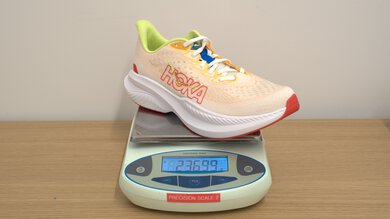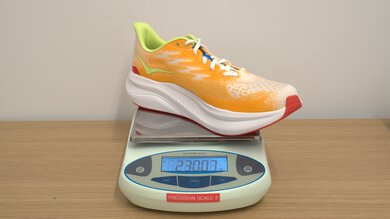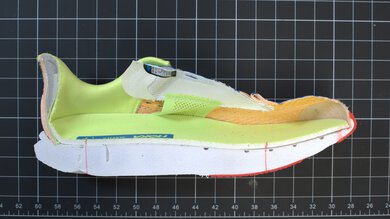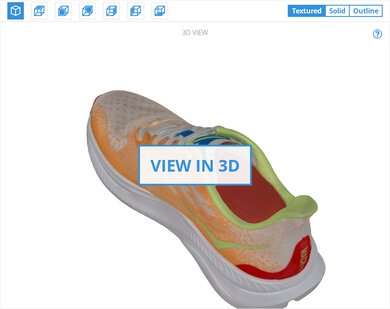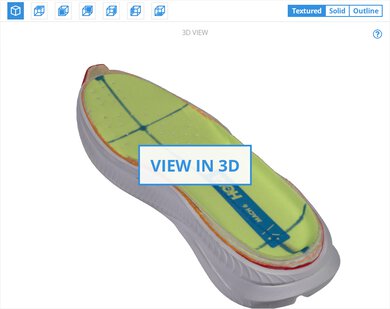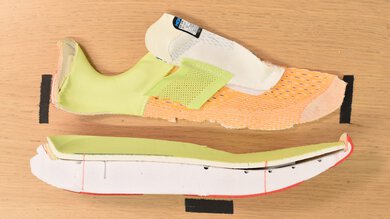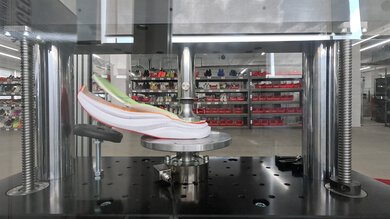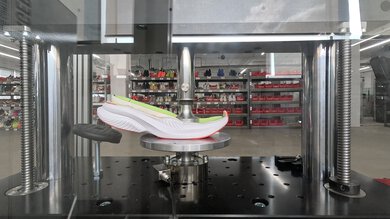The HOKA Mach 6 is a well-balanced daily trainer with features aimed at enhancing comfort while retaining a lightweight character. It has a new full-length 'supercritical' EVA midsole and added rubber outsole for a more reliable grip underfoot. The result is that it's a good jack of all trades but a master of none. While responsive, it doesn't quite match PEBA-based foams and carbon-plated options for fast workouts, and it's not as spongy and cushioned as a more maximalist daily trainer.
Our Verdict
The HOKA Mach 6 is decent as a marathon racer, although that's not its intended purpose. While it's lightweight and has good lateral stability, its cushioning and energy return are still sub-optimal for performance over long distances.
Especially lightweight for a trainer.
Decent stability for longer runs.
Very good forefoot cushioning.
No plate.
Could be more cushioned.
For 5K and 10K races, the HOKA Mach 6 performs reasonably well. Its firm forefoot and reasonable weight make it suitable enough to handle shorter, faster races. However, its energy return is just okay, and without a plate, runners seeking a snappy push-off for top speed may find it falls short compared to specialized racing shoes.
Especially lightweight for a trainer.
Forefoot is firm.
Very good forefoot cushioning.
No plate.
Could be more bouncy.
The HOKA Mach 6 provides adequate energy return. The responsiveness from the supercritical EVA foam is passable but not exceptional. This shoe won’t dramatically enhance your stride efficiency or bounce, making it better suited to daily training or moderate-paced runs rather than races where superior responsiveness matters most.
Midsole returns a fair bit of energy for a trainer.
Very good forefoot cushioning.
The HOKA Mach 6's cushioning is decent but uneven. The forefoot cushioning is good, as the midsole absorbs impacts well for shorter outings. However, the heel cushioning is just okay, and won't impress heel strikers or runners on longer outings wanting more plushness and impact protection.
Very good forefoot cushioning.
Heel is not evenly cushioned.
The HOKA Mach 6's lateral stability is decent. It offers reliable support, thanks to its good width and firmness at the heel, which helps maintain balance and efficient foot strikes, especially on fatigue-inducing runs. However, it has quite a high stack and is narrower at the arch, reducing the overall stability.
Decent stability for longer runs.
Very good forefoot cushioning.
Not especially wide outsole at the arch.
Performance Usages
Changelog
- Updated Nov 20, 2025: We've converted this review to Test Bench 0.9, which adds a Forefoot Long Run Cushioning test to our performance section. Read more in our changelog.
-
Updated Oct 20, 2025:
We've adjusted this review's writing to align with the new test bench, including updates to all usage scores, and test boxes for Cushioning, Firmness, and Energy Return.
- Updated Oct 20, 2025: We've converted this review to Test Bench 0.8.2, which updates our methodology for the impact force range used in our compression tests to improve their accuracy. This also affects all usage and performance usage boxes using those compression tests as score components.
-
Updated Jul 30, 2025:
We revised the phrasing in the Marathon, Cushioning, and Lateral Stability boxes as well as in the side-by-side comparison box with the HOKA Mach X to better align with the latest test bench scores.
Check Price
Differences Between Sizes And Variants
We tested the HOKA Mach 6 in men's US size 9, as indicated on the label. The color shown here is White/Solar Flare, and the shoe is available in several other colorways, including Black/Electric Tangerine, Stellar Grey/Black, and White/Virtual Blue. There is also an Ironman Edition featuring M-dot graphics. Wide versions are available separately for both men and women. Additionally, the Mach LS Reformation Crochet/Monogram is a different style entirely, designed for lifestyle use rather than running.
Popular Running Shoe Comparisons
The HOKA Mach 6 is a lightweight, well-rounded daily trainer that appeals to runners seeking a more minimal feel for their daily mileage. It's positioned as a lighter, simpler alternative within the daily trainer category, offering a ride that's more agile than many competitors. However, those looking for greater cushioning or bounciness might find better options elsewhere, such as the softer, more protective Mizuno Neo Vista or the adidas Adizero Evo SL, which delivers significantly more responsiveness.
Within HOKA's lineup, the Mach 6 is designed primarily for runners who prioritize lightweight efficiency and a firmer feel on everyday runs. As a daily trainer, it's more well-rounded than the more basic HOKA Clifton 10. On the other hand, the HOKA Mach X 3 is a max-cushioned super trainer that offers even more versatility for a variety of workouts. For dedicated racing, HOKA offers specialized carbon-plated options like the HOKA Cielo X 2.0.
For more options, check out our recommendations for the best running shoes.
The HOKA Clifton 10 and the HOKA Mach 6 represent two distinct takes on daily training within HOKA's lineup. The Clifton 10 is the brand's classic, comfort-oriented daily trainer, built around a higher stack of compression-molded EVA foam that prioritizes protection, impact absorption, and a plush underfoot feel. It's heavier, softer, and ideal for runners who want maximum cushioning for easy runs. The Mach 6, on the other hand, is HOKA's lighter, more stripped-down daily trainer, offering a simpler, more minimal feel underfoot that's also a bit more stable. Its midsole is more energetic, giving it a noticeably more efficient ride overall. If you're after cushioning and softness, the Clifton 10 is the way to go; if you prefer a lighter, more energetic ride, the Mach 6 is the better pick.
The HOKA Clifton 9 and the HOKA Mach 6 are both daily trainers, but each caters to slightly different preferences. The Clifton 9 is a more basic, reliable option, offering simplicity and stability for everyday mileage. The Mach 6, however, is more versatile thanks to its lighter weight, superior bounce, and more responsive cushioning. The Clifton is a good choice if you're looking for a straightforward workhorse. Still, for runners wanting more agility, responsiveness, and versatility in daily training, the Mach 6 will be the better pick.
The HOKA Bondi 9 and the HOKA Mach 6 now share the same supercritical EVA foam, but with some noticeable differences. The Bondi 9 offers a more responsive high-stack, max-cushioned experience. Though the forefoot has remained firmer, the altered rocker geometry and the renowned wide platform have created smoother transitions while offering reasonable energy return. The Mach 6 has more ground feel, thanks to its lighter weight and solid energy return, which promotes a higher cadence and allows the runner to pick up the pace, giving more versatility in their daily mileage. Overall, the Bondi 9 supremely delivers on the protection you want for your longer runs. In contrast, the Mach 6 offers more efficiency as a lightweight daily trainer for your everyday mileage.
The HOKA Mach X and the HOKA Mach 6 may share a name, but they serve distinct purposes. The Mach X is a versatile super trainer offering more cushioning and a more rolling geometry, making it suitable for easy mileage and faster-paced workouts. Meanwhile, the Mach 6 is a lighter and more classic daily trainer.
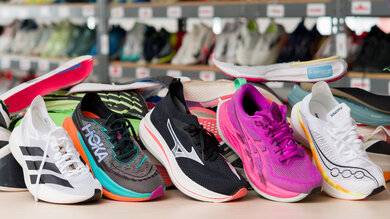
We've recently started buying and testing running shoes with a very data-oriented approach. While we're just getting started, our methodology already has dozens of tests to help you make the right purchasing decision for your needs. Not only do we use high-end equipment to gather objective data, but we also order multiple sizes of the same shoes for team members to be able to log in miles. This real-world testing is done at various paces and conditions, and with different types of workouts, to cover all the bases. This allows us to verify our results and ensure they align with what you might feel with a specific pair.
Test Results

The HOKA Mach 6 feels light, making it comfortable and suitable for daily training and even occasional racing. Although not the lightest option, it strikes a good balance, providing an efficient feel without causing fatigue from unnecessary heft. However, runners prioritizing extreme lightness for competitive racing might prefer other models like the Nike Vaporfly 3.
The heel energy return on this model is passable. The shoe’s midsole doesn't deliver impressive rebound at the heel, but it's actually energetic enough for a daily trainer. This is fine for casual runs but could leave performance-oriented runners feeling underwhelmed.
The forefoot energy return is much better than the heel but still not particularly exciting. Runners landing on the front of their foot will experience decent but uninspiring responsiveness. This makes the shoe more suitable for general training than high-speed racing.
The heel of the HOKA Mach 6 is adequately cushioned, offering fair shock absorption. The midsole compresses too easily, however, and tends to bottom out, especially for heavier runners or those putting in longer miles, potentially resulting in discomfort or fatigue during extended runs.
The forefoot cushioning initially feels good and compresses well. However, during our real-world testing, we observed the forefoot consistently bottoming out on longer runs, leading to a harsh underfoot sensation. Thus, although cushioning is good for shorter recovery efforts, many runners will notice a significant drop in comfort over extended distances.
The heel midsole offers a firm feeling under lighter loads, providing solid stability for lighter runners. However, as the applied force increases (such as heavier runners or faster-paced impacts), the shoe feels a bit softer than other options like the Nike Vaporfly 41. Overall, it offers a good balance of softness and stability.
The forefoot foam remains consistently firm and supportive through a range of loads, providing good stability. The firm forefoot also helps for efficient and dynamic toe-offs when picking up the pace, especially for midfoot and forefoot strikers.

